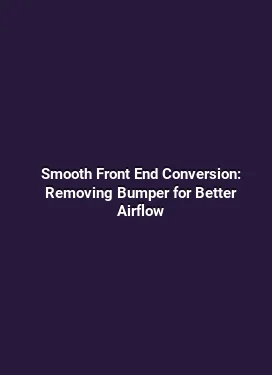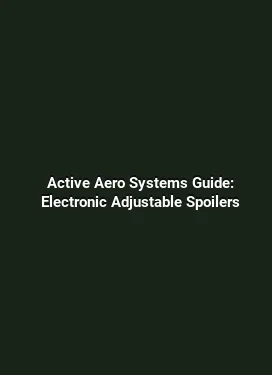How to Install Hood Pins and Quick Release Latches Properly for Enhanced Body & Aerodynamics
For performance-focused vehicles, hood security and rapid access are critical for track readiness and street usability alike. Hood pins and quick release latches are not merely cosmetic upgrades; they influence body aerodynamics, weight distribution, and functional reliability. This guide provides a comprehensive, practical path from component selection to final installation, emphasizing alignment, material choices, corrosion resistance, and integration with existing body lines. Readers will gain actionable knowledge on how to evaluate systems, prepare mounting surfaces, and verify safety and performance through controlled testing and adjustments.
Choosing the Right Hood Pins and Quick Release Latches

Selecting the appropriate hood fasteners involves balancing strength, weight, fitment, and aerodynamic impact. Materials range from lightweight aluminum to corrosion-resistant stainless steel, with some options featuring carbon fiber housings for optimized stiffness-to-weight ratios. When evaluating features, consider pull strength ratings, pin diameter, and the type of locking mechanism. A higher pull strength reduces the risk of accidental release during high-speed operation, while a compact design minimizes disruption to hood contours and front-end airflow. Additionally, look for hardware with watertight seals or splash guards to prevent moisture infiltration that could compromise fastener performance under racing conditions.
From an aerodynamic perspective, hood pins should sit flush with the hood surface and align with the outer fender line to minimize drag-inducing gaps. The goal is to maintain a smooth upper surface that integrates with the vehicle’s existing bodywork, preserving the boundary layer behavior around the hood and cowl area. Some aftermarket systems incorporate low-profile or recessed housings to further reduce airflow disturbance, which is particularly beneficial on high-speed street machines and track cars alike. When selecting quick release latches, prioritize low profile mechanisms with robust latching action and minimal protrusion to reduce parasitic drag while allowing rapid hood access during pit stops or maintenance checks.
Assessing Compatibility with Vehicle Design

Before purchasing components, map out the hood geometry, latch mounting points, and surrounding braces. Evaluate the clearance between the hood edge and the front edge of the fenders, as well as the alignment relative to the hood’s central crease. A misaligned pin can cause hood flutter, increased wind noise, and uneven load distribution across the latch assembly. For carbon fiber or fiberglass hoods, ensure the mounting surface can evenly distribute clamping pressure without crushing or inducing micro-cracks. Some hoods feature specific reinforcement zones that can accept hood pins, while others require custom brackets or integration plates. In all cases, verify that the mounting hardware does not interfere with windshield wiper mechanisms, under-hood components, or cooling ducts.
Preparation: Surface, Tools, and Safety
Effective installation hinges on meticulous surface preparation. Begin by cleaning the hood and surrounding area with a degreaser to remove oils, wax residues, and contaminants that could compromise bracket adhesion. For metal hoods, lightly scuff the mounting surface with a fine-grit pad to promote better clamp bite and corrosion resistance. If opting for stainless steel or aluminum hardware, apply a corrosion-inhibiting primer or anti-seize compound only where specified by the manufacturer to prevent galvanic corrosion between differently plated metals. When working with composite hoods, use non-abrasive cleaners and verify that the surface is free of resin fibers that might be damaged during drilling or bracket attachment.
Tools required typically include a metric drill set, a torque wrench with appropriate range, threadlocker approved for automotive use, and a caliper or ruler for precise alignment. A straight edge or laser alignment tool helps ensure pins sit perfectly perpendicular to the hood plane. Having a passenger-side mirror or alignment buddy can be valuable during the hold-and-check phase to confirm visibility of the latch engagement from the driver’s seat. Safety gloves, eye protection, and a stable work surface are essential as a foundation for accurate execution and personal protection.
Measuring and Marking for Precision
Precision begins with accurate measurements. Start by determining the intended pin height relative to the hood’s centerline, ensuring symmetric placement on both sides. Use a felt-tip marker to trace pilot locations, then double-check by dry-fitting the latch mechanism without fully tightening the screws. The goal is to have each pin engage smoothly with the corresponding bracket, with even spacing that respects the hood’s curvature. If the hood features a raised twin-slope or a pronounced center bulge, adjust the pin position to avoid contact with the hood’s underside or the rubber seal around the engine bay. Minor adjustments can have outsized effects on aerodynamics, so take time to iterate your marks until the geometry reads as a cohesive, low-drag assembly.
Mounting Techniques and Fastener Strategies
There are several robust mounting approaches for hood pins and quick release latches, each with its own set of advantages. Direct mounting to the hood panel is the most straightforward method, but it requires a solid substrate that can resist pulling forces without deforming. For lighter hoods or composite materials, using reinforced brackets that tie into underlying chassis members or subframes can distribute load more evenly and reduce the risk of hood bounce at high speeds. In some cases, manufacturers provide specific mounting plates or gasket sets designed to preserve seal integrity while offering reliable clamping contact. These plates often feature countersunk holes and a low-profile design to minimize wind-induced lift around the hood edge.
Torque control is critical. Over-tightening can crush the mounting area, while under-tightening increases the likelihood of pin loosening during operation. Adhere to the torque specifications provided by the hardware manufacturer, and use threadlocker appropriate for high-stress automotive environments. Depending on the system, you may also incorporate a secondary safety mechanism, such as a secondary locking pin or a backup latch, to safeguard against accidental release should the primary mechanism fail. When applying threadlocker, ensure the area is clean and dry to promote reliable bonding and prevent contaminant ingress through the threads.
Bracket Design Considerations for Aerodynamic Continuity
Bracket design should aim to preserve or improve the vehicle’s aero profile. Consider swaged or contoured brackets that align with the hood’s natural lines, reducing abrupt transitions that could disrupt the boundary layer. For performance-focused builds, a bracket set with a shallow angle relative to the hood surface can lessen drag while maintaining adequate clearance for safe operation. Integrate weather seals or edge gaskets where the bracket meets the hood to mitigate water intrusion and diminish wind noise. If the installation involves a moveable hinge or a locking mechanism, ensure that its travel path does not intersect with the wiper area or hood-to-cowl gaps, as improper clearance can create turbulent wake zones that hinder straight-line stability at speed.
Adjustment, Alignment, and Fine-Tuning
After initial installation, the next phase involves fine-tuning to achieve consistent engagement, repeatable hood closure, and optimal aero behavior. Start by closing the hood and verifying that the pins insert smoothly into the latching assemblies without binding. If resistance appears, inspect the pin holes for burrs or misalignment and deburr as needed. Assess hood protrusion along the front edge to ensure uniform contact with the latch housing. Small deviations at the hood edge can lead to differential pressures that create lift or drag variations during high-speed runs. Use a feeler gauge to check gaps and confirm symmetry across both sides. In addition, verify that the hood returns to its closed, flush position when the latch is engaged and that there is no open gap at the front edge that could compromise airflow management or water ingress resistance.
Testing Under Real-World Conditions
Validating the installation requires controlled testing that mirrors expected operating conditions. On a closed course or private track, perform a series of checks at incremental speeds, listening for unusual flutter, wind noise, or latch chatter. If you detect hood flutter, review the mounting points for stress concentrations and consider adding additional bracing or a supplemental brace kit that distributes load more evenly. Monitor the latch action during rapid deceleration and acceleration to ensure consistent engagement and disengagement without binding. If the vehicle has an active cooling system or openings near the hood, verify that there is no interference with airflow paths that could alter throttle response or cooling efficiency. Document any adjustments and repeat measurements to confirm repeatability and reliability across multiple sessions.
Maintenance, Durability, and Longevity
Long-term durability depends on choosing components designed for automotive environments and performing routine maintenance. Inspect pins, latches, and mounting brackets for signs of wear, corrosion, or loosening after each track day or aggressive drive. Clean hardware with non-corrosive cleaners and avoid abrasive pads that could thin protective coatings. Periodically recheck torque settings, especially after thermal cycles that cause metal expansion and contraction. Use environmentally resistant sealants to protect against moisture intrusion in exposed environments, and replace any worn fasteners promptly to prevent gradual degradation of clamping force. For street-driven cars, consider a more conservative maintenance interval since exposure to road salts and contaminants can accelerate corrosion without the high-stress conditions seen on the track.
Impact on Weight, Handling, and Overall Performance
Even marginal weight changes can influence handling and fuel efficiency, particularly in performance-tuned vehicles. Hood pins and quick release latches add weight primarily at the leading edge, where even small increments can affect the front-to-rear weight distribution. However, the benefits—improved access for inspection, maintenance, and front-end airflow management—often outweigh the minor weight penalty when chosen with lightweight materials and compact geometry. The aerodynamic benefit comes from maintaining a smooth upper surface and reducing turbulent wake behind the hood. This can contribute to more stable ride characteristics and a cleaner airflow separation, especially in configurations where the hood is a critical element of the vehicle’s aero package.
Common Pitfalls and How to Avoid Them
Rushing through installation without proper alignment is one of the most frequent mistakes. Take time to verify every measurement, mounting point, and hardware choice before drilling or fastening. Inadequate surface preparation often leads to mounting failure, especially on aluminum or composite hoods where the substrate can deform under load. Avoid over-tightening, which can strip threads or crush mounting surfaces, reducing clamping force and possibly resulting in hood misalignment. Finally, neglecting environmental protection—such as neglecting seals or protective coatings—can shorten the life of the components and increase the likelihood of corrosion. Proactive inspection and preventive maintenance help ensure consistent performance and long service life for the entire fastener system.
Integrating with Other Performance Upgrades
Hood pins and quick release latches can be coordinated with other aero enhancements, such as front splitter designs, large-diameter ducts, or vented hoods. The aim is to ensure that the hood system contributes to a cohesive aero strategy rather than becoming an isolated modification. When planning, consider how the hood’s presence interacts with the vehicle’s under-hood airflow, the radiator shroud, and the overall drag coefficient. If a vehicle already features a sophisticated aero package, work with the manufacturer’s recommended mounting points and ensure compatibility with any rapid-release modifications that affect the hood’s behavior under differential pressure. Thoughtful integration supports a harmonious balance between accessibility and aerodynamic efficiency.
Practical Tips and Best Practices
To maximize effectiveness, keep a log of installation data, including pin type, diameter, mounting location, torque values, and measured alignment tolerances. This record helps reproduce the setup on similar builds or when migrating components to another vehicle. Whenever possible, choose modular latch systems that allow swapping components without major rework, preserving your investment and enabling future aero upgrades. Consider adding simple indicators or tactile cues that confirm proper engagement even in low-light conditions, reducing the risk of inadvertent hood release during critical moments. Finally, prioritize reliability over aesthetics; a clean, functional installation that remains secure under demanding conditions will deliver greater value over time than a visually striking but unreliable configuration.
Conclusion: A Holistic Approach to Hood Fasteners
Properly installed hood pins and quick release latches deliver more than a secure hood. They contribute to a refined aerodynamic profile, facilitate quick maintenance access, and support consistent handling at speed. By carefully selecting compatible components, preparing mounting surfaces, aligning precisely, and conducting thorough testing, builders can achieve a balanced upgrade that respects the vehicle’s design language and performance goals. The end result is a system that performs reliably across a spectrum of driving scenarios—from daily driving to track sessions—while preserving the integrity of the car’s aero architecture and exterior aesthetics.






